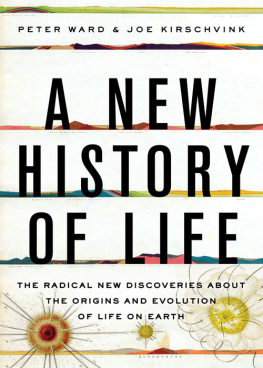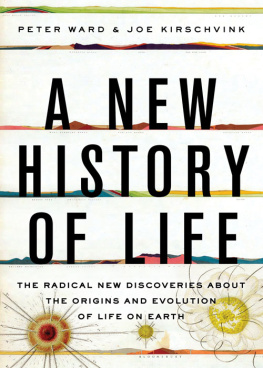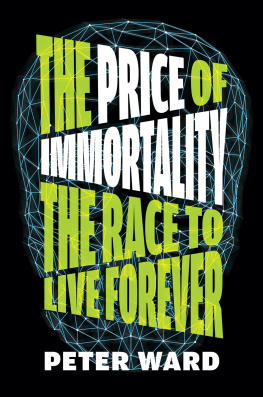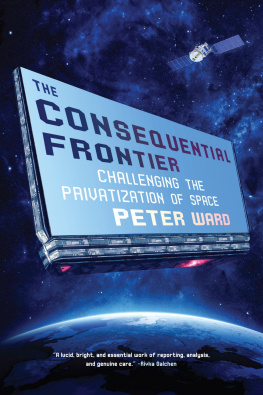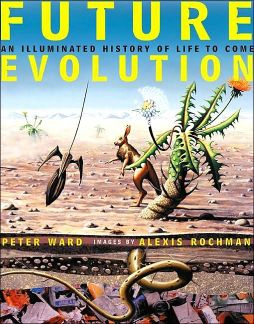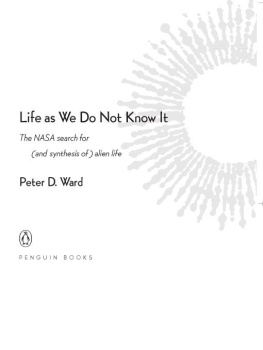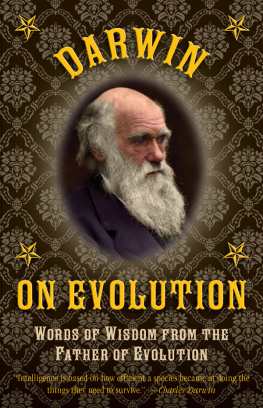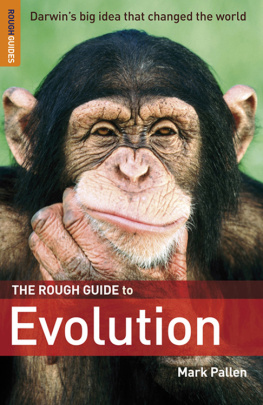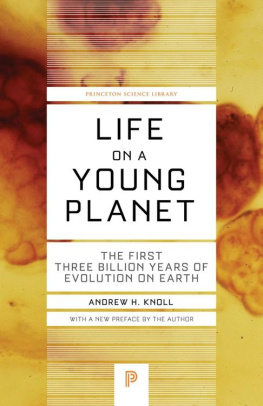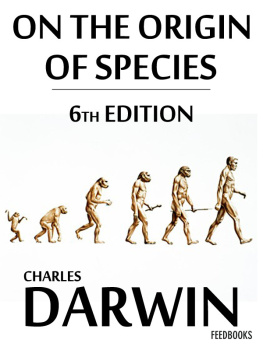
From PW: For Dr. Howard Leonard and Dr. Peter Shalit, life historians, and to the great Robert Berner, Yale University
From JK: To the memories of Dr. Eugene M. Shoemaker, Dr. Heinz A. Lowenstam, and Dr. Clair C. Patterson of Caltech. They and many others left fingerprints all over my brain.
Contents
Telling Time
Becoming an Earthlike Planet: 4.64.5 GA
Life, Death, and the Newly Discovered Place In Between
Forming Life: 4.2(?)3.5 GA
From Origin to Oxygenation: 3.52.0 GA
The Long Road to Animals: 2.01.0 GA
The Cryogenian and the Evolution of Animals: 850635 MA
The Cambrian Explosion: 600500 MA
The Ordovician-Devonian Expansion of Animals: 500360 MA
Tiktaalik and the Invasion of the Land: 475300 MA
The Age of Arthropods: 350300 MA
The Great DyingAnoxia and Global Stagnation: 252250 MA
The Triassic Explosion: 252200 MA
Dinosaur Hegemony in a Low-Oxygen World: 230180 MA
The Greenhouse Oceans: 20065 MA
Death of the Dinosaurs: 65 MA
The Long-Delayed Third Age of Mammals: 6550 MA
The Age of Birds: 502.5 MA
Humanity and the Tenth Extinction: 2.5 MA to present
The Knowable Futures of Earth Life
Introduction
History in almost any form is the academic subject perhaps most hated by school kids. One of the most thoughtful examinations was by James Loewen, in Lies My Teacher Told Me. His conclusion can be summarized in one word: irrelevance. Loewen wrote, The stories that history textbooks tell are predictable; every problem has already been solved or is about to be solved Authors almost never use the present to illuminate the pastthe present is not a source of information for writers of history texts.
Loewens message is quite clear. As American history is now taught in high schools, the past and present are disconnected, such that history has no effect on, or relevance to, our day-to-day lives. Yet that conclusion is so untrue, especially for the history of life, so ancient it is written in rocks, molecules, models, and on the DNA strands found within our every cell. Its relevance is that it gives us place and context. The history of life also just might save us from near-term extinction, if we take note of it and heed its warnings.
In the early 1960s the great American writer James Baldwin wrote: People are trapped in history, and history is trapped in them.
The history of life gives us the answers to so many of the perplexing questions confronting us all: How did we humans come to inhabit this thin, late-occurring, and very marginal twig on the giant tree of life? What wars did our species have to pass through? What calamities mark the human branch of lifes 4-billion-year-old tree? The past can help us understand our place among the twenty or more million species now livingand the untold billions now extinct. When a species is no longer extant, what is also destroyed is the as yet unrealized future evolution of untold species.
In the pages to come we will look at the long road to our present and the distant trials our long-ago ancestors had to pass through: fire, ice, hammer blows from space, poison gas, the fangs of predators, pitiless competition, lethal radiation, starvation, enormous changes of habitat, and episodes of war and conquest amid a relentless colonization of every habitable corner of this planeteach an episode that left its mark in the total sum of DNA now extant. Each crisis and conquest was a forge that changed genomes by adding or subtracting all manner of genes, each of us the descendant of survivors tempered by catastrophe and quenched by time.
There is a second and perhaps even greater reason to pay attention to the history of life encapsulated in this quote from Norman Cousins: History is a vast Early Warning System. This wisdom dates back to near the end of the Cold War. Newer generations of humans have little sense of what it was like to grow up in the 1950s and 1960s, when weekly noontime siren tests told us children of that dark time that Armageddon was but one terrifying siren scream away, and that every faint sound of a late-night jet might be the start of the end.
Human warfare has repeatedly, and seemingly incessantly, exacted a hideous toll on humanityphysically, economically, and emotionally. In many ways the history of life has undeniable similarities to human conflict and warfare. The coevolutionary development of offensive weapons by predators (better claws, teeth, gas attack, even poison-tipped barbs to catch and kill food species) caused equally rapid countermeasures in the predators prey, including better body armor, speed, hiding ability, and sometimes defensive weapons as wellall of which is technically called the biological arms race. Many of the great events of evolution cannot be repeated; evolution has had a long period to fill the biosphere with highly competitive and efficient organisms, making it unlikely to repeat, for instance, the Cambrian explosion when all of the basic body plans of animals came into being. But what can be repeated are things antipodal to living and diversifying, such as extinction, or extinction writ largerthe dreadful past catastrophes of deep time, the mass extinctions.
With every molecule of carbon dioxide we pump into the atmosphere we are ignoring the early warning sirens that rapid rises in carbon dioxide are the commonality between more than ten mass extinctions of the deep past and what is happening today. Those extinctions were caused not by asteroid impact, but from rapid increases in volcanically produced atmospheric greenhouse gases and the global warming they produced. A terrifying new paradigm of mass extinction has arisen this century: greenhouse mass extinctions, a name overtly chosen to describe the cause of the vast majority of species killed off by mass extinctions in the past.
Evidence of when, where, and how these greenhouse extinctions took place now blares at us from a wide variety of data. To those hearing these siren calls, the danger seems real enough. Yet too many have ignored or missed vast moralities from the past, and what is a possible future. The history of life provides an early warning system that tells us we must reduce human-caused greenhouse gas emissions, but it is human history that tells us that we probably will not heed the warnings and reverse the damage until a succession of climate-induced mass human mortalities gives us no choice.
Scientific information from so-called deep time is the single most ignored aspect of the climate change debate. George Santayana wrote the most oft-repeated aphorism about history, one so commonly used that it is trite: Those who ignore history are condemned to repeat it.
WHAT IS NEW IN THIS NEW HISTORY OF LIFE
No single book could ever do justice to the history of life. Choices had to be made, and those choices were largely dictated by our directive around the word new. The last complete single-volume history of life was written in the mid-1990s: the exquisite and bestselling Life: A Natural History of the First Four Billion Years of Life on Earth, by the British paleontologist and science writer Richard Fortey. His takes were marvelous and the book remains a joy to read, or in our case, to reread nearly two decades after its publication. But because science advances so quickly, there is much that was not known then compared to now. There are even two new scientific disciplines that barely existed in the mid-1990s: astrobiology and geobiology. The advances in instrumentation have led to entirely new understanding, while outcrops of strata containing fossils from times or taxa previously unknown have come to light. Even the sociology of how science is done has changed, for now the most important scientific breakthroughs are acknowledged to take place between the boundaries of the previously august and familiar disciplines of geology, astronomy, paleontology, chemistry, genetics, physics, zoology, and botanyeach symbolically separated into their own buildings on most university campuses, each with not only a faculty with its own rules and boundaries, but entire fields with their own vocabularies and favored methods of disseminating information coming from research.
Next page
